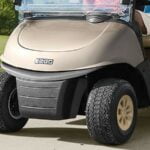Golf Carts: Five Things Every Golfer Should Know
By George Waters, USGA

Golf carts play an important role at many golf facilities. They provide a revenue source and increase accessibility, allowing golfers who might not otherwise be able to walk the course to enjoy playing. These benefits are not without their costs, however. Golf carts can have very negative impacts on turf health and playing conditions, especially in areas where traffic is concentrated. Keeping these five things in mind will help ensure that you don’t put the cart before the course during your next round.
1. The impact of cart traffic varies.
Many factors influence how cart traffic affects a golf course. Certain grasses are more vulnerable to traffic injury and may require special cart policies. Areas with heavy soils and poor drainage face a greater risk of compaction and other traffic issues. Even the time of year plays a role. When grasses are growing slowly, they are more vulnerable to the cumulative effects of cart traffic. For all these reasons, cart policies vary from course to course, hole to hole and even day to day.
2. Wet conditions and cart traffic do not mix.
Carts can slide, skid and sink when turf is wet, causing immediate and lasting damage. Wet soils are also more vulnerable to compaction, which can have negative long-term effects on playing conditions, even if those impacts are not immediately visible. Avoiding wet areas and respecting cart path restrictions is an important part of being a responsible cart driver.

3. Cart traffic during hot, dry weather can also cause problems.
It’s easy to understand that driving a cart through a soaking wet area is likely to cause problems, but many golfers are not aware that driving over dry or heat-stressed turf can also cause issues. During hot and dry weather, cart traffic increases stress on the grass and can leave behind damaged turf and straw-colored tire marks that may take weeks to heal.

4. Sometimes it’s better to take the road less traveled.
A single golf cart driving down a fairway has little to no effect on turf health or playing conditions. It is the cumulative effect of many carts that eventually takes a toll on the grass. This is why cart damage is most obvious in areas where traffic is concentrated, like the ends of cart paths. Doing your best to steer clear of high-traffic areas can greatly reduce the impact of your cart.
5. Less cart traffic means better playing conditions.
Walking or sharing a cart goes a long way toward reducing cart traffic and improving turf health. This helps courses conserve resources and provide better playing conditions for everyone.

Golf facilities use ropes, stakes, signs and many other traffic control measures to minimize the negative impacts of cart use; but ultimately, they depend on golfers to be mindful of where and how they drive. Respecting course rules, being understanding of cart restrictions and doing our best to reduce cart traffic can have a very positive impact on the courses we play. Visit the Course Care section of USGA.org to learn more.
